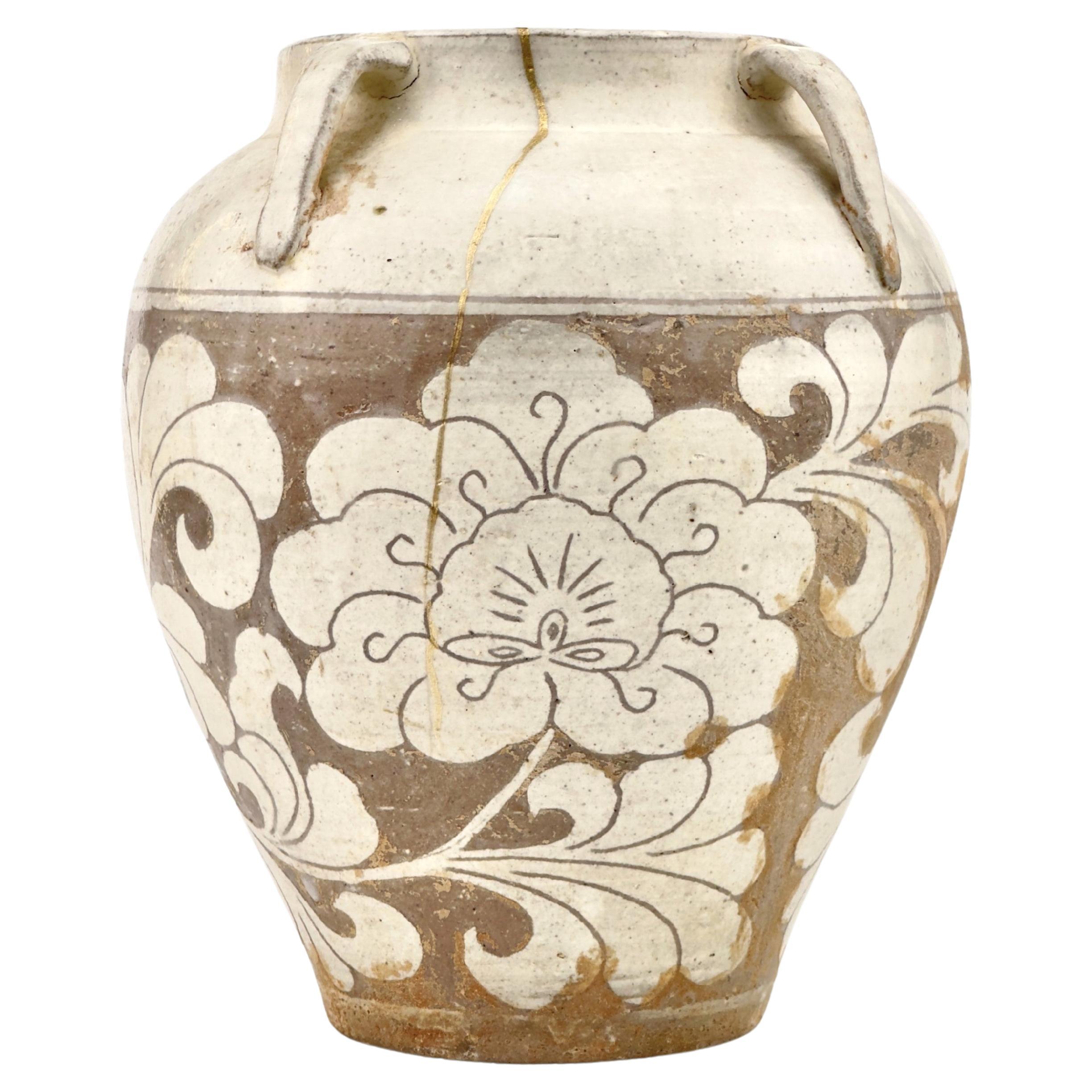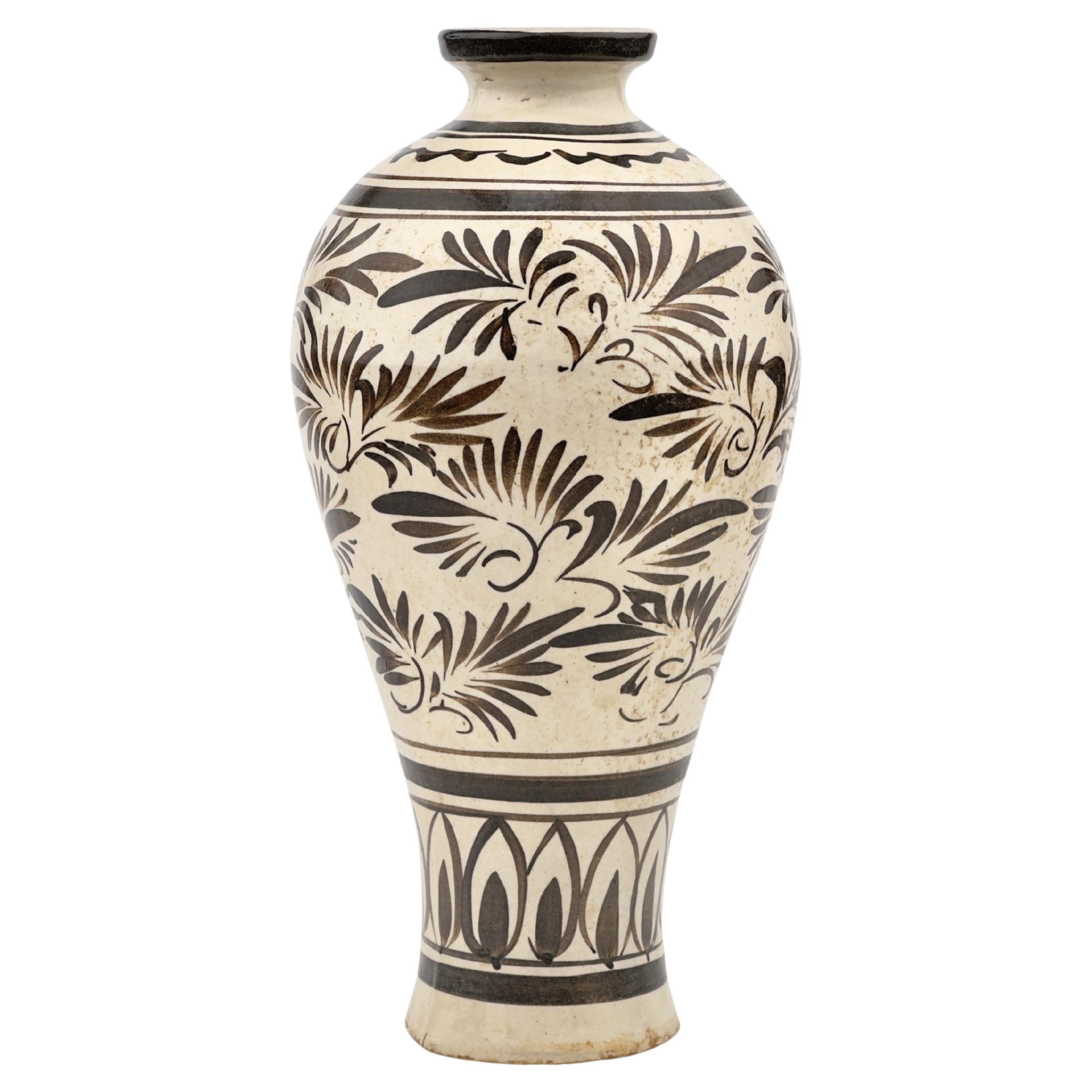Items Similar to A Carved White Ware 'peony' vase, Song-Yuan dynasty
Want more images or videos?
Request additional images or videos from the seller
1 of 13
A Carved White Ware 'peony' vase, Song-Yuan dynasty
About the Item
The vase is raised on a slightly splayed foot and flanked on the tall cylindrical neck by a pair of mask handles. The body is molded with lotus scroll pattern between a floral scroll band and an petal lappet band.
Period : Song-Yuan Dynasty(960~1368)
Type : Vase
Medium : Qingbai Ware
Provenance : Acquired in late 1990s, Hongkong
Reference :
1) Smithsonian National Museum of Asian Art - Accession Number F1984.18
2) Ashmolean Museum, Oxford - Accession no.LI1301.295
3) Sotheby's London 1 November 2023 - Important Chinese Art - Lot67
(Price : 5,080 GBP / Type : Closely related)
4) Christies Amsterdam 19–20 JUN 2012 - The Decorative Arts Sale, incl. Fine Paintings - Lot252
(Price : 4,375 Euro / Type : Closely related)
* Qingbai Ware
Qingbai ware, which translates to "blue-white ware," is a type of Chinese porcelain that was made at the Jingdezhen and other kilns in the porcelain-producing regions of China, primarily during the Song dynasty (960–1279) and continuing into the Yuan dynasty (1271–1368). It is known for its translucent quality and the pale blue-green glaze that characterizes most of its pieces.
The qingbai glaze was achieved using a small amount of iron in a reduction-fired atmosphere, which produced the subtle blue-green tint. The body of qingbai ware is typically made of a fine, white porcelain that is often referred to as 'artificial jade' due to its resemblance to the esteemed stone. The thinness of the body and the high firing temperatures used contributed to the translucent quality of the finished product.
Qingbai ware includes a range of items such as bowls, cups, vases, and ewers. The designs are usually simple and elegant, with an emphasis on the graceful lines and form of the objects. Decorative motifs, when present, are often incised, carved, or molded in relief and can include floral patterns, dragons, phoenixes, and other symbolic elements drawn from Chinese culture.
Over time, the technology and techniques used to produce qingbai ware evolved, leading to innovations in glaze and decoration that would influence later types of Chinese porcelain. Despite these changes, qingbai ware remains a distinguished example of the potters' art in Song and Yuan China, reflecting the refined aesthetic and cultural values of the period.
- Dimensions:Height: 9.85 in (25 cm)Diameter: 2.49 in (6.3 cm)
- Style:Chinese Export (Of the Period)
- Materials and Techniques:
- Place of Origin:
- Period:
- Date of Manufacture:960~1368
- Condition:Minor fading.
- Seller Location:seoul, KR
- Reference Number:1stDibs: LU9577238135172
About the Seller
New to 1stDibs
Joined in the past six months.
4.5
Vetted Seller
These experienced sellers undergo a comprehensive evaluation by our team of in-house experts.
Established in 1999
1stDibs seller since 2023
Typical response time: 1 hour
- ShippingRetrieving quote...Ships From: seoul, Korea South
- Return PolicyA return for this item may be initiated within 10 days of delivery.
More From This SellerView All
- Cizhou Lotus Carved Jar, Song-Yuan dynastyLocated in seoul, KRThis jar features a carved design, which is typical of Cizhou ware. It has a creamy white and brown color scheme, and the prominent decoration of lotus flower, which is a common motif in Chinese art and culture, symbolizing purity and enlightenment. The carving technique involves coating the vessel with a layer of white slip (liquid clay), then carving away parts of it to create the design, revealing the darker clay body beneath. This technique allows for a strong contrast between the background and the carved motif. Period : Song-Yuan Dynasty Type : Jar Medium : Cizhou Ware Size : 21.5 cm(Height), 11cm(Mouth Diameter) Provenance : Acquired in 1999, Hongkong * Cizhou Ware Cizhou is the name given to a number of stonewares, grey or buff, of varying degrees of hardness, with painted, incised or carved decoration on a clay slip. These stonewares were not only made in the region of Cizhou, Hebei Province, but in several provinces of China during the Song, Yuan and Ming periods. The great centres of production were in the north of China in the provinces of Hebei, Henan and Shanxi. Cizhou wares seem to have been very popular, made for a clientèle of rich merchants, at a period when the paintings of famous...Category
Antique 15th Century and Earlier Chinese Ming Antiquities
MaterialsPottery
- White Ware Moulded Baluster Form, Yuan Dynasty, 14th centuryLocated in seoul, KRThis vase is made from a type of low-fired, porous clay and features a crackled glaze. It bears resemblance to the renowned funerary vases and covers adorned with applied decorations...Category
Antique 15th Century and Earlier Chinese Chinese Export Antiquities
MaterialsCeramic, Porcelain
- White Ware with two dragons, Yuan Dynasty, 13-14th centuryLocated in seoul, KRThis vase is made from a type of low-fired, porous clay and features a crackled glaze. It bears resemblance to the renowned funerary vases and covers adorned with applied decorations...Category
Antique 15th Century and Earlier Chinese Chinese Export Antiquities
MaterialsCeramic, Porcelain
- A Cizhou Yuhuchunping, Yuan DynastyLocated in seoul, KRThis piece has a flared neck and a globular body, typical of the forms seen in Cizhou ware. The body is decorated with freely drawn floral motifs and abstract patterns, which may inc...Category
Antique 15th Century and Earlier Chinese Chinese Export Antiquities
MaterialsStoneware
- Cizhou Rectangular Pillow with Carved Decoration, Yuan DynastyLocated in seoul, KRCizhou ware is known for its robust forms and freely applied decoration, often featuring a white slip under clear glaze. The pillow is rectangular, with a slightly curved top surface...Category
Antique 15th Century and Earlier Chinese Ming Antiquities
MaterialsPottery, Stoneware
- Cizhou slender meiping, Yuan DynastyLocated in seoul, KRThe elongated body is fluidly painted in brown on a white slip and under a clear glaze with a broad band of abstract floral scroll between a band of upright petals below and further ...Category
Antique 15th Century and Earlier Chinese Other Antiquities
MaterialsStoneware
You May Also Like
- Yuan Dynasty, Antique Chinese Brown Glazed Pottery JarLocated in Sampantawong, THChinese brown glazed pottery jar with round shape. Age: China, Yuan Dynasty, 13th Century Size: height 21.8 cm / width 27.5 cm Condition: Well-preser...Category
Antique 15th Century and Earlier Chinese Antiquities
MaterialsPottery
- Yuan Dynasty, A Set of Rare Antique Chinese Pottery AnimalsLocated in Sampantawong, THA set of rare Chinese pottery animals. Age: China, Yuan Dynasty, A.D. 1271 - 1368 Size: Length 10.4 - 15.3 C.M. / Width 6 - 8.8 C.M. / Height 6.5 - 10.8 C.M. Condition: Well-pre...Category
Antique 15th Century and Earlier Chinese Antiquities
MaterialsPottery
- Yuan Dynasty, Antique Chinese Green Glazed Pottery Covered JarLocated in Sampantawong, THChinese green glazed pottery covered jar. Age: China, Yuan Dynasty, A.D. 1271 - 1368 Size: height 35 cm / width 25 cm. Condition: Wel...Category
Antique 15th Century and Earlier Chinese Antiquities
MaterialsPottery
- Yuan Dynasty, Antique Chinese Green Glazed Pottery Covered JarLocated in Sampantawong, THChinese green glazed pottery covered jar. Age: China, Yuan Dynasty, A.D. 1271 - 1368 Size: Height 35.7 C.M. / Width 27 C.M. Condition: We...Category
Antique 15th Century and Earlier Chinese Antiquities
MaterialsPottery
- Song Dynasty, A Pair of Antique Chinese Porcelain Vases with Dragon and GodsLocated in Sampantawong, THA pair of Song Dynasty porcelain olive green vases decorated with gods around the vase and flying dragon on top of each vase. Each lid decorat...Category
Antique 15th Century and Earlier Chinese Antiquities
MaterialsStoneware
- Song Dynasty, A Pair of Antique Chinese Porcelain Vases with Dragon and GodsLocated in Sampantawong, THA pair of Song Dynasty porcelain olive green vases decorated with gods around the vase and flying dragon on top of each vase. Each lid decorated...Category
Antique 15th Century and Earlier Chinese Antiquities
MaterialsStoneware
Recently Viewed
View AllMore Ways To Browse
Pair Small Glazed Vases
Lotus Ware
Gold Syrian Bracelet
Cream Color Chinese Ceramic Animals
Song Ding
Peranakan Silver Salver
China Ware Asian Antiquities Blue And White
Chinese Stirrups
1960s Italian Living Room
Post Modern Dining Room
Living Room Commodes
Dining Extend
Pair Of Upholstery Chairs
Art Modern Chandelier
Good Porcelain
Brass Wall Sconce Italy
France Metal Light
Lacquered Side Table





